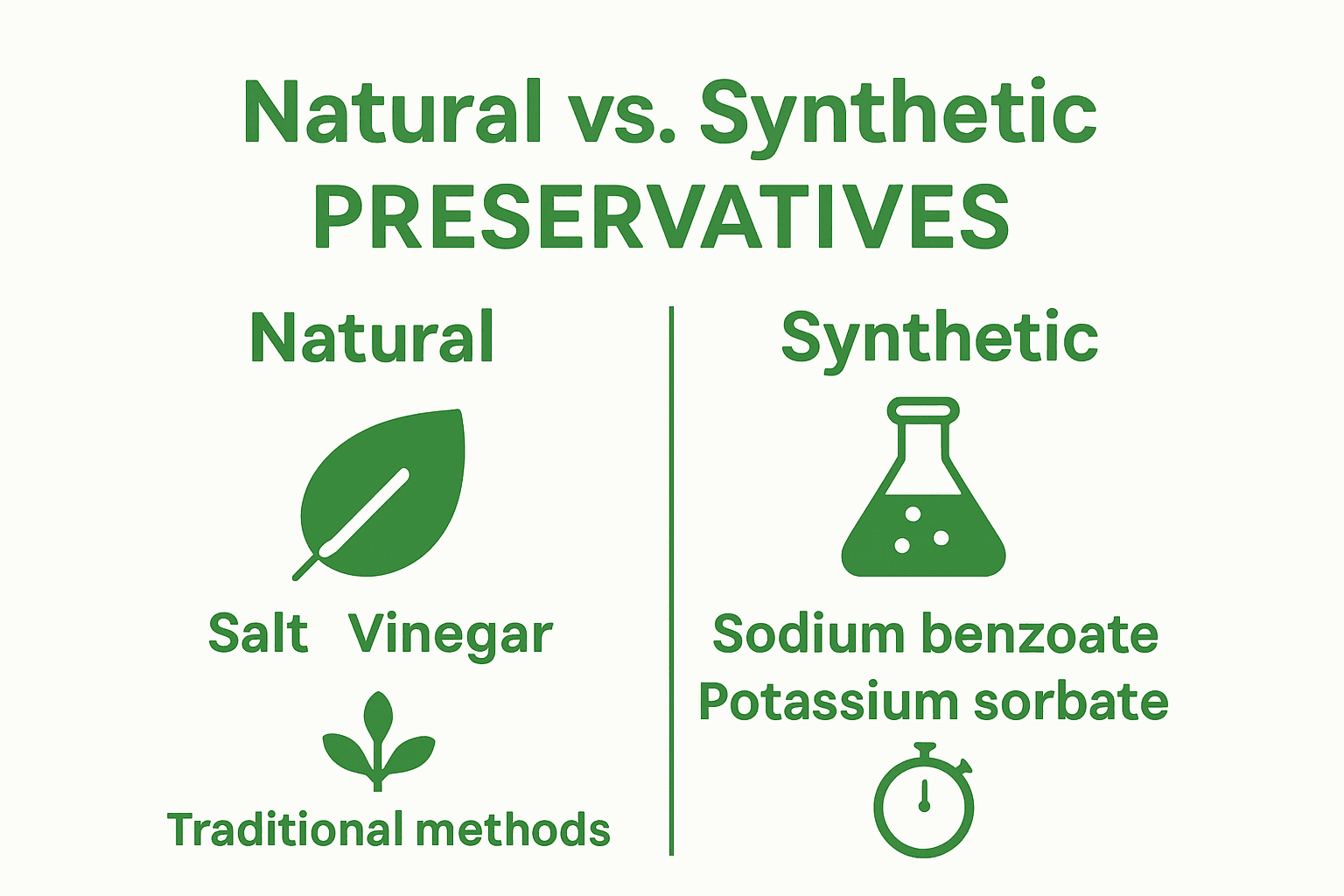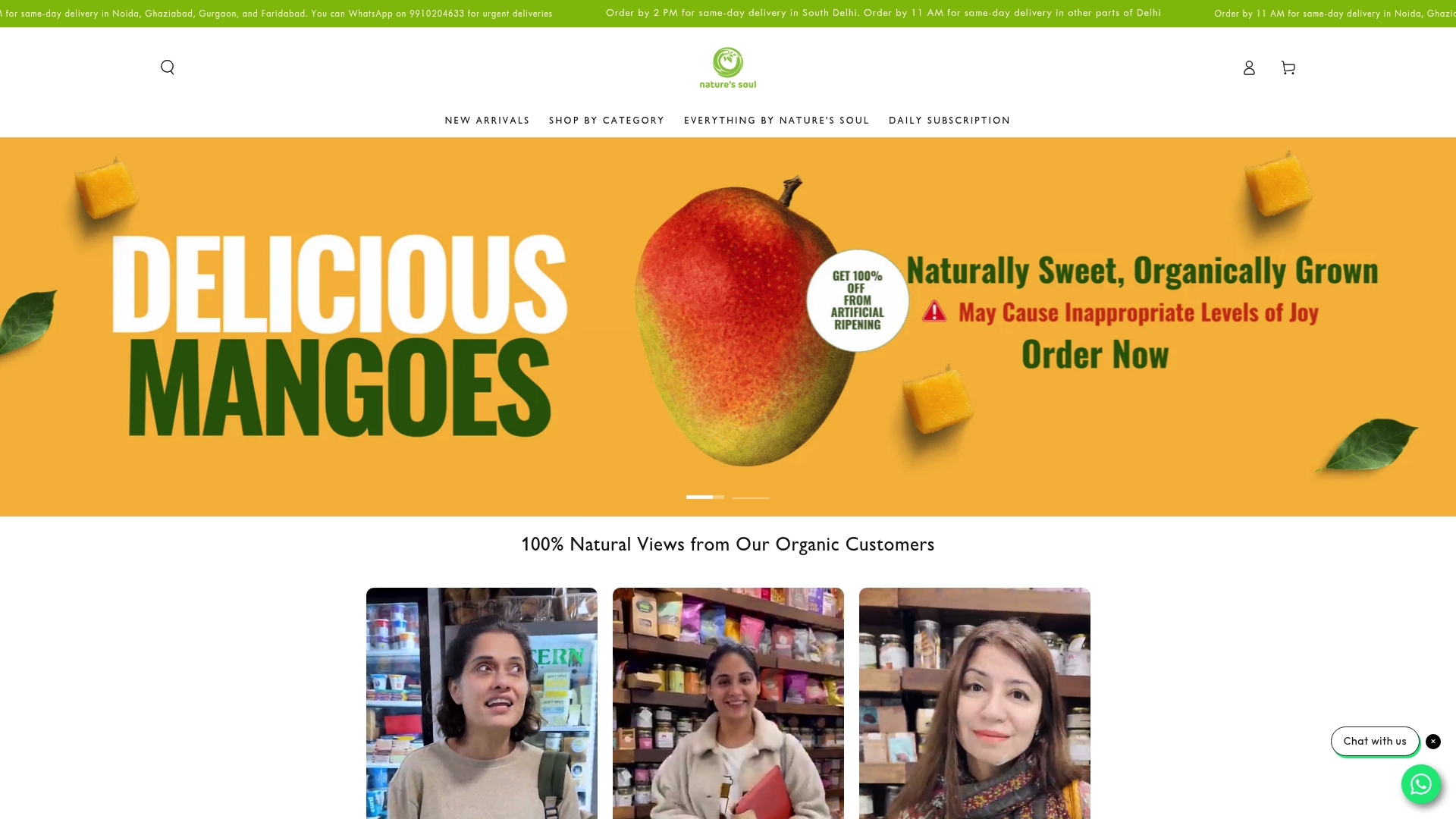Preservatives help keep your favourite foods fresh for longer and are everywhere from bread to ready meals. Most people assume the real worry is the long list of chemicals on food labels, brimming with mysterious names. Yet the biggest surprise is that approved preservatives, when eaten within recommended limits, do not pose significant health risks. That flips the usual fear on its head and opens up a whole new way of thinking about what you eat.
Table of Contents
- What Are Preservatives And Their Types?
- Why Do We Use Preservatives In Food?
- The Impact Of Preservatives On Health: Facts And Myths
- How Preservatives Work: Mechanisms And Effects
- Key Considerations For Health-Conscious Consumers
Quick Summary
| Takeaway | Explanation |
|---|---|
| Preservatives prevent food spoilage. | They inhibit microbial growth, extending shelf life and ensuring safer consumption of food products. |
| Choose natural over synthetic preservatives when possible. | Natural preservatives like vinegar and salt can be safer options, while synthetic ones may carry unknown long-term risks. |
| Understand food labels for preservatives. | Learning to identify preservatives on labels helps consumers make informed health choices and avoid potential allergens. |
| Minimise processed food intake for better health. | Focusing on whole, minimally processed foods can reduce exposure to artificial preservatives and enhance nutritional quality. |
| Be aware of common health myths about preservatives. | Recognising that approved preservatives generally pose no significant health risks can help alleviate unwarranted fears regarding food safety. |
What Are Preservatives and Their Types?
Preservatives are substances added to food, beverages, pharmaceuticals, and cosmetic products to prevent bacterial growth, slow spoilage, and extend their shelf life. These critical ingredients protect consumers from potential health risks associated with microbial contamination and help maintain product quality and safety.
Natural Versus Synthetic Preservatives
Preservatives can be categorised into two primary groups: natural and synthetic. Natural preservatives include ingredients like salt, vinegar, sugar, rosemary extract, and citric acid. These substances have been used for centuries in food preparation and storage.
 They work by creating environments that inhibit microbial growth through mechanisms like reducing moisture, altering pH levels, or introducing antimicrobial compounds.
They work by creating environments that inhibit microbial growth through mechanisms like reducing moisture, altering pH levels, or introducing antimicrobial compounds.
Synthetic preservatives, often identified by E numbers in European food labelling, are chemically manufactured additives designed to provide longer and more consistent protection against bacterial and fungal contamination. Examples include sodium benzoate, potassium sorbate, and calcium propionate, which are commonly used in processed foods, bakery products, and dairy items.
Understanding Preservative Functions
The primary purpose of preservatives extends beyond simply preventing food spoilage. They play a crucial role in:
- Maintaining food safety by preventing harmful bacterial growth
- Extending product shelf life and reducing economic waste
- Preserving nutritional quality and preventing rancidity
- Ensuring consistent taste, texture, and appearance of food products
While preservatives are essential in modern food production, consumers are increasingly interested in understanding their potential health implications. The ongoing debate surrounding preservatives involves balancing their practical benefits with potential long-term health considerations.
Below is a comparison table outlining the key differences between natural and synthetic preservatives, as described in the article.
| Type of Preservative | Common Examples | Source/Origin | Mechanism of Action | Typical Uses in Food |
|---|---|---|---|---|
| Natural | Salt, vinegar, sugar, citric acid, rosemary extract | Derived from plants, minerals, or traditional food ingredients | Alters pH, reduces moisture, introduces antimicrobial compounds | Pickles, cheese, bakery, meat |
| Synthetic | Sodium benzoate, potassium sorbate, calcium propionate | Chemically manufactured additives | Inhibits microbial and fungal growth through targeted chemical action | Processed foods, dairy, bakery |
Why Do We Use Preservatives in Food?
Preservatives are fundamental in modern food production, serving multiple critical functions that go beyond simple product longevity. They represent a sophisticated approach to ensuring food safety, quality, and economic efficiency across global food supply chains.
Economic and Safety Considerations
The primary motivation for using preservatives is preventing food waste and protecting consumer health. According to World Health Organization research, approximately one-third of all food produced globally is lost or wasted annually. Preservatives dramatically reduce this economic loss by extending product shelf life and maintaining food quality during transportation, storage, and retail display.
Moreover, preservatives play a crucial role in preventing foodborne illnesses. By inhibiting bacterial, fungal, and microbial growth, these substances protect consumers from potentially dangerous pathogens that can cause serious health complications. This protective function is especially critical in perishable products like dairy, meat, and prepared meals.
Technological and Consumer Experience Benefits
Beyond safety and economic considerations, preservatives contribute significantly to consumer experience and product consistency. They help maintain:
- Consistent taste and texture across different batches
- Nutritional integrity of processed foods
- Visual appeal by preventing discolouration
- Smooth supply chain logistics
Modern food technology relies on preservatives to create products that meet consumer expectations for convenience, reliability, and sensory quality. Without preservatives, many popular processed foods would be impractical to manufacture, distribute, and consume safely.
While preservatives offer substantial benefits, consumers are increasingly seeking transparent information about their composition and potential long-term health impacts. This growing awareness is driving innovation towards more natural and minimally processed preservation techniques.
The Impact of Preservatives on Health: Facts and Myths
The discourse surrounding preservatives is complex, with scientific research often contrasting sharply with public perception. Understanding the nuanced relationship between preservatives and human health requires careful examination of scientific evidence and potential long-term implications.
Scientific Perspectives on Preservative Safety
Research from the European Food Safety Authority indicates that approved preservatives undergo rigorous safety assessments before being permitted in food production. These evaluations include comprehensive toxicological studies that examine potential short-term and long-term health effects. Regulatory bodies establish Acceptable Daily Intake (ADI) levels, which represent the maximum amount of a substance a person can consume daily without significant health risks.
However, emerging scientific discussions suggest that while individual preservative exposure might be within safe limits, the cumulative effect of multiple preservatives in a typical diet remains an area requiring further investigation. Some studies have raised questions about potential links between certain synthetic preservatives and metabolic disruptions.
Common Health Concerns and Misconceptions
Consumers often express concerns about preservatives based on various myths and partial information. Key misconceptions include:
- All preservatives are harmful chemicals
- Natural preservatives are always safer than synthetic ones
- Preservatives directly cause chronic health conditions
- Consuming preserved foods inevitably leads to health problems
In reality, scientific consensus suggests that approved preservatives, when consumed within recommended limits, do not pose significant health risks. The regulatory framework surrounding food additives is designed to protect consumer health by setting stringent safety standards and continually reviewing scientific evidence.
While some individuals might experience specific sensitivities or allergic reactions to certain preservatives, these are generally rare and do not represent broader health risks for the general population. Ongoing research continues to monitor and assess the potential long-term impacts of preservative consumption, ensuring that food safety standards evolve with scientific understanding.
The following table highlights some of the most common misconceptions regarding preservatives and corrects them with the article’s factual explanations.
| Misconception | Factual Clarification |
|---|---|
| All preservatives are harmful chemicals | Approved preservatives are assessed for safety and are not inherently harmful. |
| Natural preservatives are always safer than synthetic | Both types have advantages; safety is determined by evidence and regulation. |
| Preservatives directly cause chronic health conditions | There is no conclusive evidence that approved preservatives cause chronic conditions when consumed within set limits. |
| Consuming preserved foods inevitably leads to health problems | Sensitivities are rare, and preserved foods do not pose general health risks for most people. |
How Preservatives Work: Mechanisms and Effects
Preservatives function through sophisticated biological and chemical mechanisms designed to prevent microbial growth, oxidation, and food degradation. Understanding these intricate processes reveals the complex science behind food preservation and safety.
Antimicrobial Action Mechanisms
Antimicrobial preservatives operate by systematically disrupting microorganism cellular functions. They target critical biological processes within bacterial and fungal cells, preventing reproduction and metabolic activities. This intervention occurs through multiple strategic approaches:
- Disrupting cell membrane integrity
- Interfering with enzymatic processes
- Blocking protein synthesis
- Preventing cellular energy production
By systematically compromising microorganism survival strategies, preservatives effectively create an inhospitable environment that prevents spoilage and potential pathogenic contamination.
Oxidation Prevention and Chemical Stabilization
Beyond antimicrobial action, preservatives play a crucial role in preventing chemical degradation. Antioxidant preservatives interrupt oxidation processes that cause food components to break down, protecting nutritional quality, flavor, and visual appearance. This mechanism is particularly important in fatty foods, where rancidity can rapidly develop.
The chemical interactions between preservatives and food molecules are complex. Some preservatives neutralize free radicals, while others chelate metal ions that might trigger oxidative reactions. This sophisticated chemical intervention extends product shelf life and maintains sensory characteristics that consumers expect from packaged foods.
Modern food science continues to evolve preservation techniques, focusing on developing more natural, efficient methods that balance safety, nutritional integrity, and consumer preferences. The ongoing research aims to create preservation strategies that are both highly effective and minimally intrusive to the original food’s characteristics.
Key Considerations for Health-Conscious Consumers
Navigating the complex landscape of food preservatives requires informed decision-making and a strategic approach to dietary choices. Health-conscious consumers must develop critical skills in understanding food labels, recognizing potential risks, and making empowered nutritional selections.
Reading Labels and Understanding Ingredients
Harvard School of Public Health research recommends carefully examining ingredient lists to identify synthetic preservatives. Consumers should look for specific chemical names or E-numbers that indicate preservative content. Key preservatives to watch include:
- Sodium benzoate
- Potassium sorbate
- Sulfites
- Nitrites and nitrates
- Calcium propionate
Understanding these ingredients allows individuals to make more informed choices about their dietary intake.
 Some preservatives might trigger sensitivities or allergic reactions in certain individuals, making label comprehension crucial.
Some preservatives might trigger sensitivities or allergic reactions in certain individuals, making label comprehension crucial.
Strategies for Minimising Preservative Exposure
Health-conscious individuals can adopt several practical strategies to reduce preservative consumption. Learn more about clean ingredients and their benefits to support your nutritional goals. Recommended approaches include:
- Prioritising whole, minimally processed foods
- Choosing fresh produce over packaged alternatives
- Selecting organic and locally sourced products
- Preparing meals from scratch using whole ingredients
- Supporting food producers committed to natural preservation techniques
While complete elimination of preservatives is challenging in modern diets, strategic reduction can significantly improve overall nutritional quality. Consumers should focus on balance, diversity, and understanding the role of preservatives in food production, rather than adopting an extreme or fearful approach to food consumption.
Choose a Healthier Way to Protect Your Wellbeing
Are you feeling concerned about preservatives in your daily food and home care products after reading about their possible cumulative effects and the ongoing debates over synthetic versus natural options? It is only natural to want better choices for yourself and your family, especially if you are aiming to limit exposure to chemicals and prioritise clean ingredients.

The good news is you do not have to compromise on safety or purity. At Natures Soul Shop, we are passionate about offering organic, natural, and genuinely clean products across all categories. When you seek out fruits, vegetables, meats, dry groceries, vegan, gluten free, dairy, or even home care and skin care essentials, you can trust that our commitment to wellness means zero synthetic preservatives and greater peace of mind. Make the switch today and experience the difference that clean, thoughtfully sourced ingredients can make in your life. Visit Natures Soul Shop now and discover a safer, more wholesome way forward.
Frequently Asked Questions
Are preservatives harmful to my health?
Preservatives, when consumed within recommended limits, do not pose significant health risks. Regulatory bodies assess their safety rigorously, and approved preservatives undergo thorough testing before being allowed in food production.
What are the differences between natural and synthetic preservatives?
Natural preservatives include ingredients like salt and vinegar, which have been used for centuries, while synthetic preservatives are chemically manufactured additives designed for longer shelf life. Each has its own advantages and uses in food preservation.
How do preservatives extend the shelf life of food?
Preservatives work by preventing microbial growth and chemical degradation. They inhibit the growth of bacteria and fungi, and antioxidants protect against oxidation, which can cause food spoilage and loss of quality.
Can I avoid preservatives entirely in my diet?
While it is challenging to eliminate all preservatives from your diet, you can reduce your exposure by prioritising whole, minimally processed foods and preparing meals from scratch. Selecting organic and locally sourced products can also help in minimising preservative consumption.






